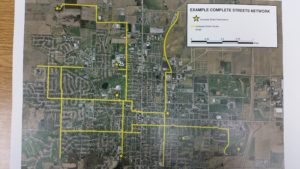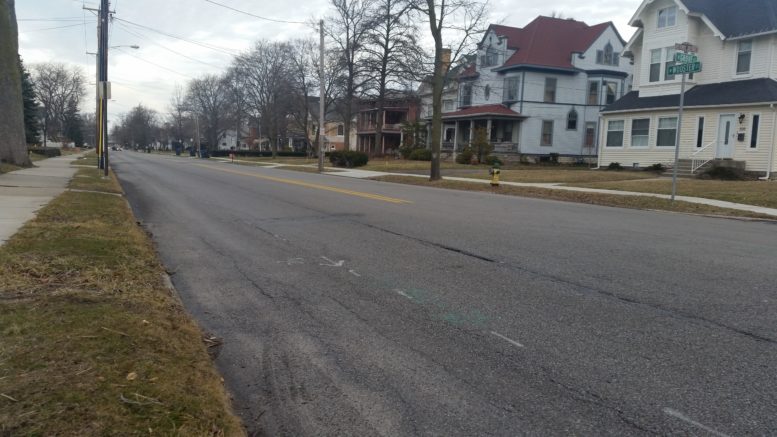By JAN LARSON McLAUGHLIN
BG Independent News
Before Bowling Green peddles out its Complete Streets proposal, officials want to hear from those who pedal the most through the city.
Complete Streets is the name given to a national effort to make streets safe for all users, including pedestrians, bicyclists, motorists and transit riders of all ages and abilities.
“They consider all modes of transportation,” explained councilman John Zanfardino. “They are created with not just cars in mind.”
But the difficulty in cities like Bowling Green is that the streets were planned and constructed with motorists in mind. So retrofitting the streets for all modes of transportation will mean some extra costs for the city and some compromises for motorists.
Council chambers was full Monday evening of citizens who had questions about how to make city streets more friendly to all users.

Example of possible Complete Streets Network in Bowling Green
The streets committee presented an example of a “Complete Streets Network” that mapped out routes to various destinations in the city. The network covered sections of such streets as Clough, Court, Campbell Hill, Manville, Thurstin, North College, Pearl, Wintergarden, Conneaut, Lafayette, Poe, Maple, Fairview, Van Camp and Newton.
But city officials need to know from bicyclists if this network includes the best streets for the plan.
“We really do need to come up with a map,” Zanfardino said.
“I think bicyclists should have a lot of communication with the city about what they need,” said council member Sandy Rowland.
The lack of a plan not only leaves bicyclists without better routes around the city, but it also leaves the city’s engineering department in limbo.
City Engineer Jason Sisco said most “Complete Streets” language used across the nation includes vague generalities. There are no specific standards, “which is what we live by in the engineering world,” he said.
Some cities, such as Piqua, have plans that consider 25 mph streets as safe for cars and bikes to co-mingle. By that standard, several streets in Bowling Green then already qualify. And that means when the city repaves South Church Street this year, it does not need to make any special accommodations, Sisco said.
“So we may think that is a Complete Street. But what we think and what you’re thinking might be two different things,” he said.
And city officials don’t want to repave a street one year to find out the next that it should have been modified for the Complete Street plan.
The council committee discussed narrower streets where sharrows could alert motorists to possible bicyclists with the use of painted bike graphics on the pavement edge. Sharrows are not like bike lanes, in that they don’t offer extra space for the pedaling traffic.
“Essentially, it’s a reminder to not be a bad driver,” council member Daniel Gordon said.
“That is the cheapest way to go,” Rowland said.
Sisco pointed out that bike lanes on some streets would require widening that would impact trees, utilities and fire hydrants. On some streets, such as North Grove, which is planned for repaving this year, it could require the elimination of street parking.
To implement a Complete Streets program, the city needs to know if items like trees and parking can be eliminated to make room for bikes.
“What are items off the table,” Sisco asked.
Gordon said he didn’t want to rule out anything in the initial planning stages. “The only thing I don’t want to see us do is nothing.”
“We have some very dedicated bicyclists in Bowling Green,” Gordon said.
Citizens brought up concerns about no accommodation for bicyclists riding to the high school or middle school, no safe route for bicyclists at the Copper Beach apartment complex on the east side of Interstate 75, and concerns about neighborhoods with no residential parking except for on streets.
The Complete Streets committee agreed to work with the city’s Bicycle Safety Commission, which will meet next on March 15 at 6 p.m., in the city administration building.

